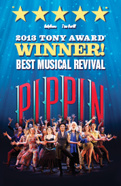Tony-Nominated Director Diane Paulus on Bringing Her ‘Dangerous’ Circus-Inspired Pippin to Broadway
About the author:
Diane Paulus first took Broadway by storm in 2009, when her vibrant interpretation of Hair in Central Park transferred to the Hirschfeld Theatre. Since her acclaimed Broadway debut, the three-time Tony-nominated director has helmed two more groundbreaking revivals on the Great White Way: a passionate Porgy and Bess in 2012 and a reimagined, circus-inspired Pippin in 2013, starring Matthew James Thomas in the title role and Tony nominee Patina Miller as the Leading Player. Below, Paulus, who also serves as artistic director of the American Repertory Theater in Cambridge MA, traces her journey with Pippin from a third-grade birthday party to Broadway.
![]()
When I was in third grade, I went to see Pippin on Broadway with one of my classmates. It was her birthday, and I remember being in her Upper East Side apartment, getting dressed up in our fancy party dresses. The whole thing felt so adult and sophisticated. When we arrived at the Imperial Theatre, I was mesmerized. Watching Ben Vereen and the Fosse choreography, I remember feeling Pippin was inviting me to enter this dangerous, mysterious world, full of seduction. And I thought, “That’s the world I want to be in.”
Pippin has always been part of my life since then, and has remained one of my favorite musicals. I made up a dance to the Manson Trio music with my best friend which we performed in our seventh grade talent show, and I even sang “With You” at my brother’s wedding (although now that I’ve directed the show, I’m appalled, because in the context of the show it’s a song about Pippin falling in love with multiple women!). While I have always loved the score, my work on Pippin over the last few years has deepened my appreciation for the theatrical power that lies at the heart of the show. My passion is making theater that includes the audience as a partner—and Pippin does this. It constantly breaks the fourth wall.
I have always wanted to direct a production of Pippin. I felt very strongly that Bob Fosse’s choreography was inextricably linked to the original production and it had to be a part of any revival. But I could never just do a replica of the original version—that’s not my forte. So I was stalled for a bit, struggling with the notion of “Who are the players? What is their identity?” And I was just getting to know the work of Les 7 Doigts de la Main, an incredible Montreal-based circus company. I knew I wanted to collaborate with them, and I had a light bulb moment: What about Pippin and Les 7 Doigts de la Main?
I talked to Stephen Schwartz and he said, “If you’re interested in keeping a Fosse element in your production, you should meet Chet Walker.” Chet was in the original Pippin and he worked closely with Bob Fosse. I told him about my idea of adding circus and acrobatic elements to the production, and he told me how Mr. Fosse was fascinated by the circus. A lot of the original choreography featured the dancers pantomiming juggling and swallowing swords. Chet said, “I think this idea of the circus would be a natural extension of what Mr. Fosse did 40 years ago.” And I thought, “Wow, maybe we’ve got something here.”
At first, combining the Fosse dancing with the acrobatics was a complicated challenge. When we began rehearsing at A.R.T., our early versions of “Magic to Do” weren’t working. The dancing and acrobatics were operating on separate tracks. After several weeks of working this way, we realized we needed to approach the whole thing differently. The acrobatics needed to feel like they’re exploding out of the dancing—it had to be seamless and integrated. This took an enormous amount of time. It took weeks just to train and perfect the acrobatic tricks. Meanwhile, the dancers were working with a rigorous precision to execute the choreography. Everyone had to be completely precise in their spacing. Once everyone was sure of exactly where they would be at all times, we would combine them. No one in the company was used to working this way.
The biggest joy for me has been discovering that the acrobats want to sing, the dancers want to flip on their heads and the musical theater veterans want to try circus tricks. When we first rehearsed “Simple Joys,” I kept moving Patina to the side so she wouldn’t get hit. But then we found out she could hula hoop—and sing at the same time—and we died. Everybody was on the floor, stomping our feet and clapping. And it turns out, Terry Mann can throw knives. And of course, Andrea Martin does something special in “No Time at All.” When I look out onstage and see her perform that number, every acrobat is enraptured, watching this veteran star perform. Everyone on that stage shares a common foundation of great respect for one another.
It’s so pleasing to sit in the audience of the Music Box Theatre and see people who waited 40 years to see Pippin again—people like me. My oldest daughter is eight, the age I was when I first saw Pippin, and it’s especially exciting to see children her age in the audience, who are being drawn in not only by the spectacle and the acrobatics and the music, but by the story. I’m delighted to have the opportunity to pass on the gift I received 40 years ago to a new generation of young people searching for their own corner of the sky.
